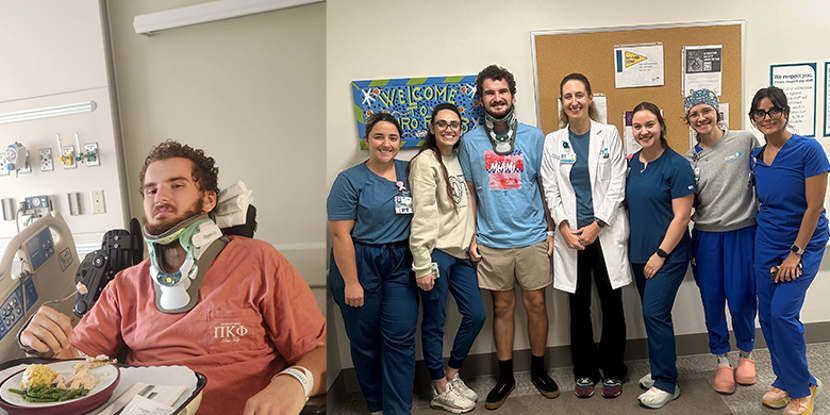What to pack in your hurricane go-bag
- Category: Healthy Living
- Posted on:

We’re no strangers to hurricanes here in south Louisiana. Yet it seems like every year, we plan to prepare for hurricane season—but life just gets in the way. Before we know it, a tropical storm is in the forecast, forcing us to scramble to gather supplies and make a plan.
Here are a few recommendations to add to your hurricane prep list now, so you’re ready.
When is hurricane season?
Hurricane season technically runs from June through November but peaks from mid-August to late October.
Severe storms and hurricanes are more likely to develop quickly during this time, often bringing dangerous flooding, winds, tornadoes, and power outages. They can destroy homes and businesses and even put your life at risk. Experts say that the best way to weather hurricane season safely is being prepared.
Your hurricane emergency plan
Everyone needs an emergency plan for you, your family, and anyone else in your krewe, it’s time to make one.
A hurricane emergency plan outlines what you’ll do in response to a hurricane or tropical storm threat. You may have to leave home quickly. Where will you go? How will you get there? Will you have access to a vehicle? Talking through these things ahead of time makes it easier on you if there’s an emergency.
If you need help with evacuation, remember you can text EVACNOLA to 77295. There are also city-assisted evacuation options.
What to pack in case of hurricane evacuation
Your hurricane plans should also include a go-bag that stays packed and ready. Review some of the items that every household should have ready to go in the event of hurricane evacuation.
Gas
Keep a full tank of gas in your vehicle when a storm threatens.
Personal identification and important documents
During hurricane season, there’s always the threat of flooding, which can damage your important documents. Have them packed or easily available in case of flooding or if you need to leave your home. Put documents in a labeled waterproof container or ziplock bag, so they don’t get lost or damaged during a storm.
Consider including copies of these items for each family member:
- Birth and marriage certificates
- Driver’s license
- Medical records
- Proof of insurance
- Property deeds
- Social security card
- Vehicle registration
- Will and insurance documents
Cash
Although we live in a very digital world, cash is important—especially during bad weather or natural disasters, when banks close and ATMs may not be available. Businesses that are open may only accept cash, so having it can help if you need extra supplies as you evacuate.
First aid kit and prescriptions
A first aid kit is a must for your hurricane go-bag. Include health-related items and medicines your family may need, such as prescription medications and over the counter medications commonly used. List out all medications each family member has and other important health concerns. Your kit should also contain other items, such as waterless hand cleaners, antibacterial soap, and sunscreen.
Toiletries
An emergency pack needs toiletries that you’d use daily. Gather deodorant, toothpaste, toothbrush, soap, and any other personal items. Keep in mind that some of these items have expiration dates and may need to be changed out periodically.
Bottled water
Water is a necessity, so make sure you have it bottled and ready to go. Plan for each person to use one gallon of water per day.
Food
It helps to have at least four days’ worth of food for each person in your family. Pack the following types of food:
- High-energy foods: These foods don’t contain much water and fill your stomach more. Examples are peanut butter, crackers, and protein or energy bars.
- Pre-packaged, non-perishable foods: Foods like oatmeal, mac and cheese, fruit snacks, tuna, and chips or pretzels are pre-packaged foods that last a long time. Pack enough to accommodate your family’s size, and update it every hurricane season as needed.
Electronics
Along with a charged phone or communication device, these electronics and related supplies are most helpful to have on hand:
- Batteries: Batteries are critical for preparation during inclement weather. Additionally, pack your cell phone charger, computer cords, and a wind-up or solar-powered charger.
- Flashlight: Each family member should have their own flashlight. Wind-up flashlights work well and don’t require batteries.
- Lantern: A lantern is a nice addition to a flashlight. It helps light larger rooms and frees your hands if you need them both.
- Radio: Check that your radio is battery-operated and tape the frequency for the weather channel to the radio, so you can easily tune to that station.
Clothes and shoes
You should pack enough clothes for four days per person. Make sure you have your rain jacket, protective shoes, and a hat for shade.
Pets and pet supplies
Your pets are part of hurricane preparedness, too. Check that all your pets are correctly identified and always wearing their collars with tags. Their identification tag should have your cell phone number and address. Getting your pets microchipped helps your chances of finding your pet if they’re ever separated from you.
When leaving your home, take your pets with you. As you consider your evacuation plans, find areas where pets are welcome. If you can’t bring your pets with you, you should secure other arrangements, such as friends, relatives, kennels, or a vet’s office, ahead of time.
For your pet, pack:
- Bedding
- Bottled water and bowls
- Carrier or crate
- Pet food
- Plastic refuse bags or litter
- Tags, collar, and leash
- Vet information and medications
Emergency preparedness resources at LCMC Health
For emergency preparedness updates from LCMC Health and other weather resources, visit our Emergency Preparedness webpage and follow us on social media.
